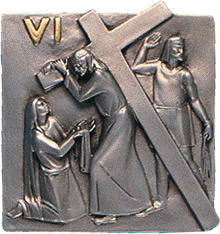 What
are the Stations of the Cross?
What
are the Stations of the Cross?
Christians have always wanted to walk in the footsteps of Jesus to the cross. For most of us this opportunity will not arise. However some pilgrims were able to return from the Holy Land with stories of their adventures and wanted to remember the 'way of the cross.'
It was the Franciscans who first promoted the use of scenes from the last journey of Jesus to the cross. This was no doubt inspired by the Crusaders who often erected tableaux of places they had visited in the Holy Land. So has developed a devotion which has come to be called the 'Stations of the Cross.'
The seventeenth century marks the time at which 'Stations' were placed on
church walls. These 'Stations' or 'gathering places,' were centered around
wooden crosses, with a scene from the last journey of the Passion placed
beneath them. Over the years there have been as few as five, or over 30
'Stations.' In 1731 the number was fixed by Clement XII at fourteen. Nine of
these commemorated events in the Gospels and five were taken from early
tradition
So, when we hear the term 'Stations of the Cross' what we are usually
referring to is a series of pictures or carvings depicting fourteen
incidents in the last journey of Christ before his burial. Most churches
will use them devotionally at during Lent or Holy Week.
The Stations can be taken alone or in the context of a church service, when
a verse from the hymn Stabat Mater is sometimes sung between each of the
stations. An English version of this hymn is found in Hymns Ancient and
Modern New Standard) No 69. The congregation goes from one picture to the
next, led by the priest recalling Christ's last hours.
- Pilate condemns Jesus to death
- Christ receives the cross
- Christ falls to the ground
- Christ meets his mother
- Simon of Cyrene takes the cross
- Christ has his faced wiped by Veronica
- Christ falls a second time
- Christ tells the women of Jerusalem not to weep for him
- Christ falls a third time
- Christ is stripped of his garments
- Christ is nailed to the cross
- Christ dies on the cross
- Christ's body is taken down
- Christ is placed in the tomb
On Good Friday 1991, Pope John Paul II, according to long standing papal tradition, led a crowd of people at the Roman Colosseum through the Stations of the Cross. However, he changed the format, altering the fourteen stations and adding a fifteenth. Some of the traditional ones were kept, while others were dropped and new ones inserted. All of the stations the Holy Father used had as their basis incidents recorded in the gospels. Using this service in our own church we follow through the last days in the life of our Lord and as we seek to die with Christ so we also seek to rise to new life on Easter Sunday. You may take this service and use it in your own prayer times.
 Link to Stations of the Cross order of service
Link to Stations of the Cross order of service
Link to powerpoint display of the Via Dolorosa also available in Adobe

